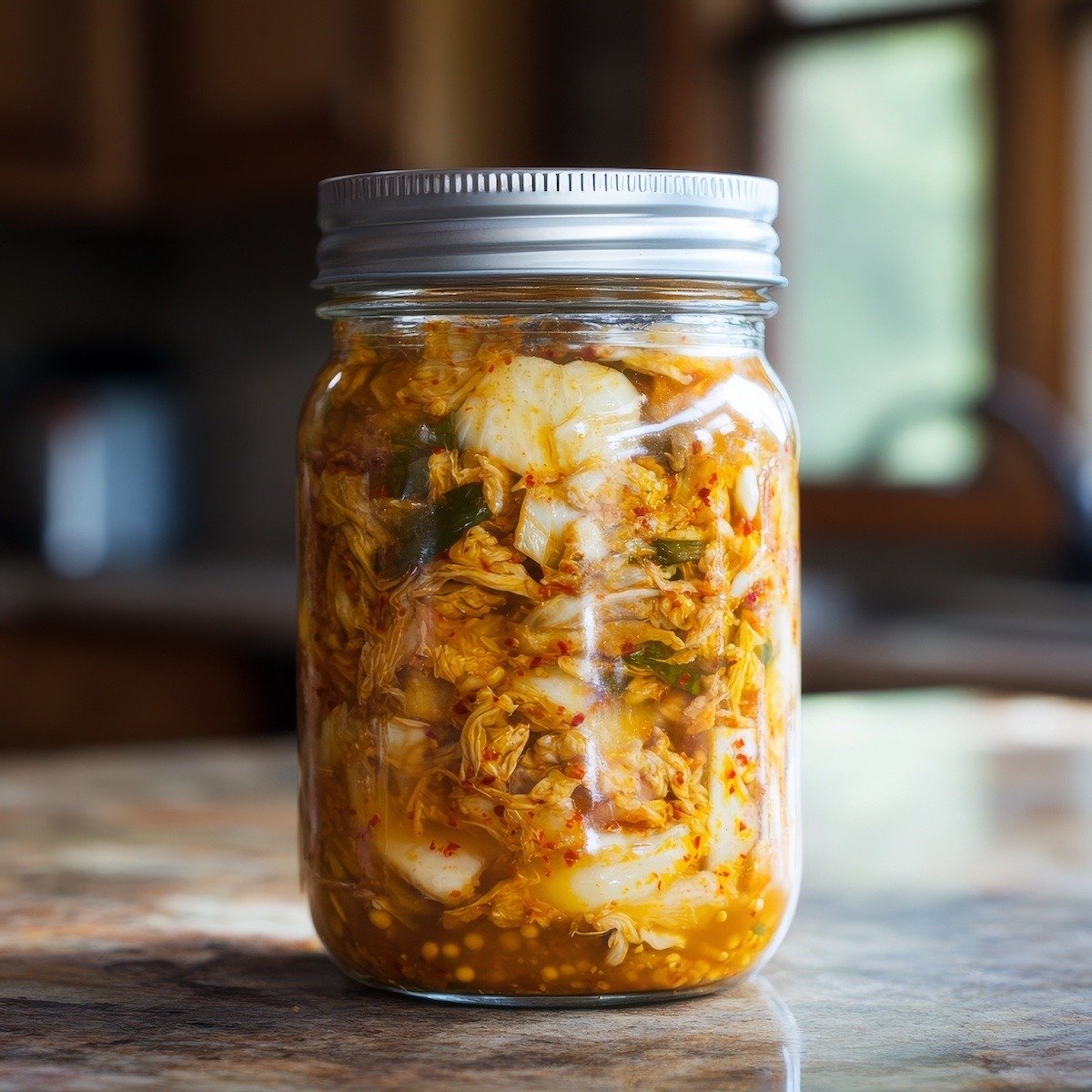Explore the World of Fermentation: Homemade Kimchi, Sauerkraut, and Pickles
Fermentation transforms essential ingredients into rich, flavorful staples and preserves food naturally. Whether you crave spicy kimchi, tangy sauerkraut, or crisp pickles, fermenting at home offers an accessible and rewarding way to create these delicious, gut-friendly foods.
At its core, fermentation involves beneficial bacteria breaking down sugars in the food, producing lactic acid. This process not only preserves the food but also enhances its flavor and creates a probiotic-rich environment that supports digestive health.
In this post, I’ll explore the basics of fermentation and guide you through making kimchi, sauerkraut, and pickles at home. You don’t need fancy equipment or specialized skills—just fresh ingredients, patience, and a love for bold, tangy flavors.
Fermenting at home also lets you customize your recipes, experimenting with spices and seasonings to suit your taste. Whether you’re a seasoned fermenter or a curious beginner, this guide will help you tap into the ancient art of fermentation and add vibrant, healthy dishes to your table. Let’s get started on this flavorful journey!
What Is Fermentation?
Fermentation preserves food naturally by using beneficial microorganisms, such as bacteria and yeasts, to transform and preserve it. These microorganisms break down carbohydrates (like sugars) in the food, converting them into acids, gases, or alcohol, depending on the type of fermentation.
The most common form of fermentation used in food preservation is lactic acid fermentation, where bacteria convert sugars into lactic acid. This process creates an environment that prevents harmful bacteria from growing, extending the food’s shelf life.
The acidity produced during fermentation acts as a natural preservative, preventing spoilage and helping to retain the food’s nutrients. Fermentation not only preserves food but also enhances its flavor, texture, and nutritional value. It can increase the bioavailability of vitamins and minerals and introduce beneficial probiotics, which support gut health.
Foods like kimchi, sauerkraut, yogurt, kefir, miso, and pickles are all examples of fermented foods that have delighted people for centuries, thanks to this simple and effective preservation technique.
History of Fementation
Kimchi has a long and fascinating history that dates back over two millennia. Originating in Korea, it evolved out of the need to preserve vegetables during harsh winters when fresh produce was scarce. Early forms of kimchi were simple fermented vegetables without the spice and seasoning commonly associated with it today.
Ancient Origins:
- The earliest mentions of kimchi in Korea can be traced back to around 37 B.C. to 7 A.D., during the Three Kingdoms period. Back then, the focus was on fermentation as a preservation method, using salt to keep vegetables edible for extended periods.
- These early versions were likely similar to modern-day pickled vegetables, lacking the signature spiciness of contemporary kimchi.
Introduction of Chili Peppers:
- Portuguese traders from the Americas introduced chili peppers to Korea in the 16th century, transforming kimchi into the dish we know today. Before that, kimchi was often made with a mixture of vegetables and salted fish for flavor, but the arrival of chili peppers added the heat and vibrant red color that now characterize many varieties of kimchi.
- Chili peppers became integral to the seasoning, combined with garlic, ginger, and fermented seafood, creating the complex flavors now synonymous with kimchi.
Evolution and Diversity:
- Over the centuries, kimchi continued to evolve, with different regions of Korea developing their variations based on local ingredients and climates. In coastal areas, for instance, kimchi might contain more seafood, while in colder regions, fermentation was slowed down to allow for longer storage.
- Kimchi is now enjoyed in countless forms, ranging from the classic napa cabbage variety (baechu kimchi) to white kimchi (baek kimchi), which is milder and does not contain chili peppers. Seasonal variations also emerged, with special types of kimchi made for certain times of the year, such as dongchimi, a watery radish kimchi enjoyed in winter.
Cultural Significance:
- Kimchi is more than just a dish; it is deeply embedded in Korean culture and identity. In 2013, UNESCO recognized the tradition of making kimchi, known as “Kim Jang, “ as an Intangible Cultural Heritage of Humanity. Kimjang involves communities coming together to make large quantities of kimchi to last through the winter months, reinforcing communal ties and preserving an important cultural practice.
Today, kimchi is celebrated worldwide for its bold flavors and health benefits, but its roots remain firmly planted in Korean history and culture.

Fermentation Steps
The basic steps in fermentation, especially for making foods like kimchi, sauerkraut, and pickles, are simple but require careful attention. Here’s a general guide:
Preparation of Ingredients:
- Select Fresh Produce: Choose fresh, high-quality vegetables or fruits for fermentation. Common choices include cabbage, cucumbers, and radishes.
- Clean and Cut: Wash the produce thoroughly to remove dirt and impurities. Chop or slice the vegetables as needed for your recipe.
- Optional: Pre-Salting: Some recipes call for salting the vegetables before fermentation to draw out moisture and enhance texture.
Salt the Vegetables:
- Add Salt: Salt plays an essential role in fermentation by creating an environment that favors beneficial bacteria and inhibits harmful ones. Mix the vegetables with the appropriate amount of salt. For sauerkraut, aim for about 2% salt by weight of the vegetables.
- Massage the Vegetables: In recipes like sauerkraut, massaging the salted vegetables helps release their juices, which will act as the brine.
Pack the Vegetables into a Fermentation Vessel:
- Choose a Vessel: Use a clean, non-reactive container, such as a glass jar or ceramic crock.
- Pack Tightly: Firmly pack the vegetables into the vessel, ensuring they are submerged in their juices or added brine to prevent exposure to air.
Fermentation Process:
- Cover and Weigh Down: Place a weight on top of the vegetables to keep them submerged. Cover the vessel loosely to allow gases to escape while keeping contaminants out.
- Ferment at Room Temperature: Store the vessel at room temperature, out of direct sunlight, for several days to weeks, depending on the recipe and desired flavor.
Monitor and Taste:
- Check Daily: Monitor the progress of fermentation daily to ensure the vegetables remain submerged. Skim off any surface mold or scum that forms.
- Taste Testing: Begin tasting the ferment after a few days. The flavor should develop a tangy, sour taste as the process continues. Once you achieve the desired taste, the fermentation is complete.
Store:
- Refrigerate: Transfer the fermented food to the refrigerator once fermentation is complete. This slows down the process and extends the food’s shelf life.
By following these basic steps, you can ferment a variety of foods at home, creating delicious, probiotic-rich dishes.
Storage and Shelf Life
Fermented vegetables can last several months to over a year when you prepare and store them properly. The longevity of these vegetables depends on the type of vegetable, the fermentation process, and the storage conditions. Here’s what you need to know:
Storage of Fermented Vegetables:
- Refrigeration:
After completing the fermentation process, store your fermented vegetables in the refrigerator. The cold temperature slows down the fermentation process, preventing the vegetables from becoming overly sour or mushy.
In the fridge, fermented vegetables typically last 4 to 6 months, sometimes up to a year or longer. The flavor will continue developing much more slowly than during the active fermentation phase. - Cool, Dark Storage:
If you lack refrigerator space, store the fermented vegetables in a cool, dark place like a root cellar. This method works well if the temperature stays consistently cool (around 55°F or 13°C).
In these conditions, fermented vegetables can last several months, but you should monitor them more frequently than if they were in the refrigerator. - Fermentation Vessel:
Ensure the vegetables remain submerged in their brine during storage to prevent exposure to air, which can lead to spoilage. If the brine level decreases, top it up with salted water to keep the vegetables submerged.
Signs of Spoilage:
While fermented vegetables have a long shelf life, watch for signs of spoilage:
- Off Smell: A foul or unpleasant odor indicates something went wrong.
- Mold: While some surface mold can occur during fermentation, if mold continues to develop or penetrates below the surface, the vegetables may no longer be safe to eat.
- Slimy Texture: Fermented vegetables should remain firm and crunchy. If they become excessively slimy or mushy, they may be spoiled.
When you store fermented vegetables properly, they remain safe to eat and often improve in flavor, becoming more complex and tangy over time.
 Fermented Pickles
Fermented Pickles
Health Benefits
Fermented vegetables are generally very good for you! They offer a range of health benefits, primarily due to the fermentation process itself. Here are some of the key benefits of consuming fermented vegetables:
1. Probiotics:
- Fermented vegetables are rich in probiotics, beneficial bacteria supporting gut health. These probiotics help balance the gut microbiome, improving digestion and boosting immunity. Consuming fermented foods can help replenish the good bacteria in your digestive system, especially after taking antibiotics or during periods of digestive imbalance.
2. Improved Digestion:
- The fermentation process partially breaks down the food, making it easier for your body to digest and absorb nutrients. Fermented vegetables can also help alleviate common digestive issues like bloating, gas, and constipation.
3. Enhanced Nutrient Availability:
- Fermentation can increase the bioavailability of certain nutrients, making them easier for your body to absorb. For example, the fermentation process can boost levels of vitamins, particularly B vitamins and vitamin K2, and enhance the absorption of minerals like iron and zinc.
4. Antioxidants:
- Fermented vegetables contain antioxidants, which help protect your cells from damage caused by free radicals. These antioxidants contribute to overall health and may reduce the risk of chronic diseases.
5. Boosted Immune System:
- A healthy gut is closely linked to a strong immune system. The probiotics found in fermented vegetables can help support immune function by maintaining a balanced gut microbiome and preventing the overgrowth of harmful bacteria.
6. Reduced Inflammation:
- Some studies suggest that probiotics from fermented foods help reduce inflammation in the body, which is linked to various chronic health conditions, including heart disease and autoimmune disorders.
7. Low in Calories and Nutrient-Dense:
- Fermented vegetables are typically low in calories but packed with fiber, vitamins, and minerals. This makes them a nutritious addition to almost any diet, particularly those looking to improve overall health without adding extra calories.
Important Considerations:
- While fermented vegetables offer numerous health benefits, consuming them in moderation is important, especially if you’re new to probiotics. Introducing too many fermented foods at once can lead to digestive discomfort. Additionally, those with certain health conditions, like histamine intolerance, should consult a healthcare professional before adding fermented foods.
Regularly incorporating fermented vegetables into your diet can improve digestive health, improve nutrient absorption, and strengthen your immune system.












